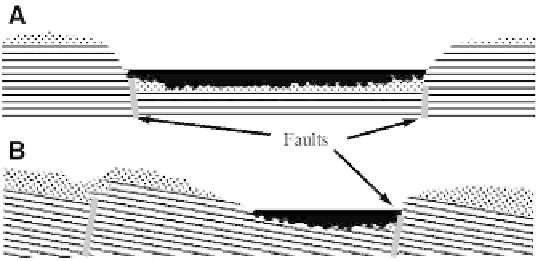Environmental Engineering Reference
In-Depth Information
Ways That Lakes Form and Essential Characteristics of Each Type
a
TABLE 6.3
Lake type
Formation process
Essential characteristics and examples
Tectonic
Basin formed by movement of Earth's
Can be very old and very deep; Lake
crust: graben, a block slips down
Baikal, Asia, and Lake Tanganyika,
between two others; horst, diagonal
Africa
slippage
Pothole or kettle
Formed when ice left from retreating glacier
Small lakes/wetlands; prairie pothole
is buried in till (solid material deposited
region in Alberta and North and
by glacier) and then melts
South Dakota
Moraine
Glacial activity deposits a dam of rock
Narrow, fill valley
and debris
Earthslide
Movement of earth dams a stream or river
Similar to reservoirs; Quake Lake,
Montana
Volcanic—caldera
Volcanic explosion causes hole that is filled
Often round and deep; Crater Lake,
with water
Oregon
Dissolution lake
Limestone dissolves and lake forms
Small, steep sides
Oxbow
River bend pinches off, leaves lake behind
Shallow, narrow, may be seasonally
flooded
a
Many more types are possible (Hutchinson, 1957).
Glacial
activity is responsible for the formation of many lakes in the
temperate regions and for the formation of more lakes than any other process
(Fig. 6.5). Several processes associated with glacial activity lead to lake for-
mation. Glaciers scour as they move down valleys. The ice flow of these glac-
iers creates basins. Lakes occur where glaciers have scoured more deeply,
leading to the formation of
cirque
(also called tarn lakes) lakes in the “am-
phitheaters” at the heads of the valleys. The glacier forms chains of
pater-
noster
lakes as it flows further down the valleys (Figs. 6.7 and 6.8). Glacial
scour can lead to formation of extremely large lakes. The Great Slave Lake
in Canada was carved to a depth of 464 m below sea level by the massive
weight of the continental ice sheet and is the deepest lake in North America.
The Laurentian Great Lakes of North America (e.g., Superior, Huron, and
Erie) were partially formed by glacial action.
Fjord
lakes such as Loch Ness
(the home of a legendary creature) are long glacial lakes formed in steep val-
FIGURE 6.4
Diagrams of two modes of lake formation associated with tectonic processes:
(A) graben, a block drops below two others; and (B) horst, blocks tip and a lake forms along
a single fault line.





Search WWH ::

Custom Search